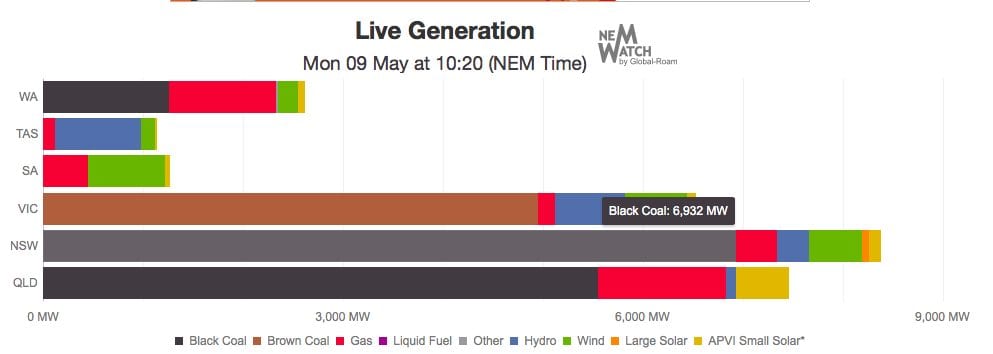The 520MW Northern brown coal power generator, the last coal-fired power station in South Australia, was switched off for the last time on Monday morning, setting the state on a new path to a decarbonised grid.
The facility in Port Augusta was switched off by its owner, Alinta Energy, ending more than 31 years of generation. Its smaller and older adjoining facility at Playford was switched off last year, due to falling wholesale power prices caused by the influx of renewable energy such as wind and solar.
This graph above, from RenewEconomy’s Live Generation widget, shows the absence of coal soon after the power station was closed down just after 9.40am local time.
The local community at Port Augusta hopes that the coal-fired generator can be replaced by solar power, with strong community support for a 110MW solar tower and storage facility to be built just north of the town.
Both the Coalition and Labor has indicated their interest in supporting solar tower technology, but may not do it any time soon, despite a growing need to dispatchable generation as the share of wind and solar PV rise above 50 per cent – a level that is expected to be reached later this year.
Port Augusta Mayor Sam Johnson told the Adelaide Advertiser that, in light of the election being called, it was time for both major parties to “put their money where their mouth is”.
“It’s a sad day to see the end of this,” Johnson said. “It’s no secret that the Upper Spencer Gulf wants to transform into a renewable resource centre. We are now in election mode and we ask that the governments put their money where their mouth is … the time has come.”
Another opportunity is a tender being held by the South Australian government for “low-carbon” technology. The solar tower is thought to have a good chance at this, although awarding a contract to existing gas-fired generation has also been discussed.
The withdrawal of the last coal-fired generator has raised fears in some quarters of a loss of grid stability and soaring power prices.
.
However, the Australian Energy Market Operator says there should be no increased risk to reliability as a result of the closure, and has made clear a short blackout in November was not caused by too much or too little wind energy, as many had suggested, but by equipment failure worsened by the actions of a gas-fired generator that did not follow market instructions.
Scare campaigns have also been waged on power pricing, with many businesses locking in to high-priced contracts with local retailers. However, one analyst has pointed out that these customers are paying twice what they need to pay.
The price of electricity on the wholesale market did jump sharply on Monday – above $200/MWh – although those jumps were replicated in most states in the National Electricity Market.
Traders said part of the reason was the season of “outages” – with some coal fired generation on maintenance and others, such as the 2,000MW Liddell coal plant in NSW, offline for two months because of boiler tube leaks.
They said South Australia pricing could be more volatile because the withrawal of Alinta market is now dominated by two major generation companies, AGL Energy and GDF Suez, with more than 60 per cent market share between them. The Australian Energy Regulator has raised concerns about this situation, and blamed “strategic bidding” for surges in spot prices in the market in 2011.










